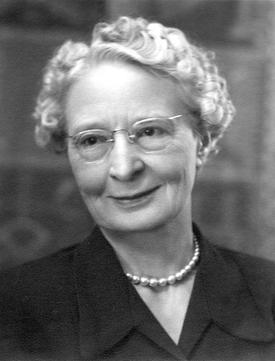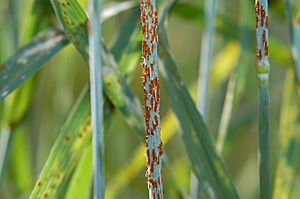Margaret Newton facts for kids
Quick facts for kids
Margaret Newton
|
|
|---|---|
 |
|
| Born | 20 April 1887 |
| Died | 6 April 1971 (aged 83) Victoria, British Columbia, Canada
|
| Citizenship | Canadian |
| Alma mater | Macdonald College (McGill University) |
| Known for | Stem rust research |
| Awards | Flavelle Medal (1948) |
| Scientific career | |
| Fields | Plant pathology, mycology |
| Thesis | Studies in wheat stem rust (Puccinia graminis tritici) (1922) |
| Doctoral advisor | Elvin C. Stakman |
Margaret Brown Newton was a famous Canadian scientist. She was a plant pathologist and mycologist. This means she studied plant diseases and fungi. Margaret Newton was known around the world for her work on a plant disease called stem rust. This disease mainly affected wheat, which is a very important crop in Canada.
Margaret Newton was born on April 20, 1887, and passed away on April 6, 1971. People described her as friendly, determined, and very hardworking. She often worked until she was completely exhausted!
Contents
Early Life and Education
Margaret Newton was born in Montreal, Quebec. Her father was a chemist who was interested in how science could help farming. She had four younger brothers and a sister.
Margaret started school in a small, one-room schoolhouse. Later, her family moved to Montreal, where she went to middle school and high school. They then moved back to Plaisance, where she finished high school. She even taught at her old school for a year. After that, she went to Toronto Normal School to train as a teacher.
She taught for several years, saving her money for more education. Margaret loved art and first studied it at McMaster University. But she soon moved to Macdonald College in Montreal to study agriculture. She was the only girl in a class of 50 students! She was also the top student and won an award called the Governor General's Academic Medal.
At Macdonald College, Margaret became very interested in plant diseases. Her professor, W.P. Fraser, was studying a serious disease called cereal rust. This disease was destroying huge amounts of wheat crops in Western Canada. Margaret began to help him with his research. She even discovered that different types of stem rust spores could infect wheat in different ways.
In 1918, Margaret and her friend Pearl Clayton Stanford made history. They were the first women to earn a degree from Macdonald College. The next year, Margaret earned her Master's degree. Her research focused on how different wheat types resisted the stem rust fungus. She continued to be the top student in her class.
Groundbreaking Research on Stem Rust
After college, Margaret Newton was offered a research job at the University of Saskatchewan. She later became an assistant professor there. While teaching, she also worked on her Ph.D. at the University of Minnesota. In 1922, she became the first woman in Canada to earn a Ph.D. in agricultural science. Her studies focused on wheat stem rust.
In 1925, the Canadian government asked Margaret to help lead a new research center. This was the Dominion Rust Research Laboratory in Winnipeg. It was created because stem rust had caused so much damage to wheat crops in previous years. Margaret became the main plant pathologist there. She started a yearly survey to track stem rust across Western Canada. She found many different types, or "races," of the rust. This helped her discover which wheat types could resist the disease.
Margaret published many scientific papers about stem rust. Her work was very important because it helped scientists create new types of wheat that could fight off the rust. This research saved Canadian farmers millions of dollars. Before her work, stem rust destroyed about 30 million bushels of wheat each year. Thanks to her, wheat rust is no longer a major problem in Canada!
Her research became famous worldwide. Scientists from other countries, especially those that grew a lot of grain, wanted to learn from her. Margaret traveled to the United States, Europe, and even Russia to share her knowledge. In 1933, the Soviet Union invited her to train their scientists. They were worried about their own crop losses from stem rust.
Later Life and Retirement
Working with stem rust spores for so many years affected Margaret's breathing. Because of this, she retired early in 1945 and moved to Victoria, British Columbia. Farmers even asked the Canadian government to give her a full pension (retirement money). They said she had "saved the country millions of dollars."
Even in retirement, Margaret continued to help. She traveled to Russia and Africa to assist with programs to fight rust. She also attended scientific meetings and conferences. She enjoyed hobbies like birdwatching and canoeing, and she loved to tend her garden.
Margaret Newton passed away in Victoria on April 6, 1971.
Legacy and Awards
Margaret Newton received many awards and honors for her amazing work.
- In 1942, she became the second woman ever to be chosen as a Fellow of the Royal Society of Canada. This is a very high honor for Canadian scientists.
- In 1948, she won the Flavelle Medal from the Royal Society of Canada. She was the first person from an agricultural college and the only woman to receive this award.
- In 1956, the University of Minnesota gave her an Outstanding Achievement Award.
- In 1969, the University of Saskatchewan gave her an honorary Doctor of Laws degree.
- A building for female students at the University of Victoria was named Margaret Newton Hall in her honor in 1964.
- In 1997, she was recognized as a Persons of National Historic Significance by the Canadian government. A special plaque was placed at the University of Manitoba to celebrate this.
- She was also inducted into the Canadian Science and Engineering Hall of Fame in 1991.
- In 2008, she was inducted into the Manitoba Agricultural Hall of Fame.
Margaret Newton's dedication to science helped protect Canada's wheat crops and made a lasting impact on agriculture worldwide.


